Sliding Mode Control of Electro-Hydraulic Position Servo System Based on Adaptive Reaching Law
Abstract
:1. Introduction
2. Problem Formulation and Dynamic Models
3. Design of Sliding Mode Controller Based on Adaptive Reaching Law
3.1. Design of Sliding Surface
3.2. Controller Design
3.3. Characteristic Analysis of SMC Controller Based on Adaptive Reaching Law
- Approach from the initial postion . At this stage , ignoring the term influence, that is , by integrating it, we obtainand as
- From , approach . At this stage , ignoring the shadowing of , that is, , by integrating it, we obtainand as
4. Simulation Analyses
5. Conclusions
Author Contributions
Funding
Institutional Review Board Statement
Informed Consent Statement
Data Availability Statement
Conflicts of Interest
References
- Li, Y.; He, L. Counterbalancing Speed Control for Hydrostatic Drive Heavy Vehicle Under Long Down-Slope. IEEE/ASME Trans. Mechatron. 2015, 20, 1533–1542. [Google Scholar] [CrossRef]
- Wang, C.; Jiao, Z.; Wu, S.; Shang, Y. Nonlinear adaptive torque control of electro-hydraulic load system with external active motion disturbance. Mechatronics 2014, 24, 32–40. [Google Scholar] [CrossRef]
- Wang, C.; Jiao, Z.; Quan, L. Nonlinear robust dual-loop control for electro-hydraulic load simulator. ISA Trans. 2015, 59, 280–289. [Google Scholar] [CrossRef] [PubMed]
- Pi, Y.; Wang, X. Trajectory tracking control of a 6-DOF hydraulic parallel robot manipulator with uncertain load disturbances. Control Eng. Pract. 2010, 19, 185–193. [Google Scholar] [CrossRef]
- Ma, Y.; Li, D.; Li, Y.; Yang, L. A Novel Discrete Compound Integral Terminal Sliding Mode Control with Disturbance Compensation for PMSM Speed System. IEEE/ASME Trans. Mechatron. 2022, 27, 549–560. [Google Scholar] [CrossRef]
- Ma, H.; Xiong, Z.; Li, Y.; Liu, Z. Sliding Mode Control for Uncertain Discrete-Time Systems Using an Adaptive Reaching Law. IEEE Trans. Circuits Syst. II Express Briefs 2021, 68, 722–726. [Google Scholar] [CrossRef]
- Ma, H.; Li, Y. A Novel Dead Zone Reaching Law of Discrete-Time Sliding Mode Control with Disturbance Compensation. IEEE Trans. Ind. Electron. 2020, 67, 4815–4825. [Google Scholar] [CrossRef]
- Ma, Z.; Liu, Z.; Huang, P. Fractional-Order Control for Uncertain Teleoperated Cyber-Physical System with Actuator Fault. IEEE/ASME Trans. Mechatron. 2021, 26, 2472–2482. [Google Scholar] [CrossRef]
- Utkin, V.I. Sliding Modes in Control and Optimization; Springer Science & Business Media: Berlin, Germany, 2013. [Google Scholar]
- Knohl, T. Sliding Mode Control in Electromechanical Systems. Utkin, J. Guldner, J. Shi, Taylor & Francis, London, 1999. Control Eng. Pract. 2000, 8, 1417–1418. [Google Scholar]
- Slotine, J.-J.E.; Li, W. Applied Nonlinear Control; Prentice Hall: Englewood Cliffs, NJ, USA, 1991; Volume 199. [Google Scholar]
- Levant, A. Universal single-input-single-output (SISO) sliding-mode controllers with finite-time convergence. IEEE Trans. Autom. Control 2001, 46, 1447–1451. [Google Scholar] [CrossRef] [Green Version]
- Laghrouche, S.; Plestan, F.; Glumineau, A. Higher order sliding mode control based on integral sliding mode. Automatica 2007, 43, 531–537. [Google Scholar] [CrossRef]
- Defoort, M.; Floquet, T.; Kokosy, A.; Perruquetti, W. A novel higher order sliding mode control scheme. Syst. Control Lett. 2009, 58, 102–108. [Google Scholar] [CrossRef] [Green Version]
- Tian, Q.-y.; Wei, J.-h.; Fang, J.-h.; Guo, K. Adaptive fuzzy integral sliding mode velocity control for the cutting system of a trench cutter. Front. Inf. Technol. Electron. Eng. 2016, 17, 55–66. [Google Scholar] [CrossRef]
- Lian, R. Adaptive Self-Organizing Fuzzy Sliding-Mode Radial Basis-Function Neural-Network Controller for Robotic Systems. IEEE Trans. Ind. Electron. 2014, 61, 1493–1503. [Google Scholar] [CrossRef]
- Sira-Ramirez, H. On the dynamical sliding mode control of nonlinear systems. Int. J. Control 1993, 57, 1039–1061. [Google Scholar] [CrossRef]
- Xue, L.; Zhiyong, G. Adaptive Sliding Mode Tracking Control for Nonholonomic Wheeled Mobile Robots with Finite Time Convergence. In Proceedings of the 36th China Control Conference, Dalian, China, 26–28 July 2017; pp. 721–726. [Google Scholar]
- Pandey, A.; Agrawal, R.; Mandloi, R.S.; Sarkar, B. Sliding mode control of dynamic voltage restorer by using a new adaptive reaching law. J. Inst. Eng. India Ser. B 2017, 98, 579–589. [Google Scholar] [CrossRef]
- Ma, Z.; Liu, Z.; Huang, P.; Kuang, Z. Adaptive Fractional-Order Sliding Mode Control for Admittance-Based Telerobotic System with Optimized Order and Force Estimation. IEEE Trans. Ind. Electron. 2022, 69, 5165–5174. [Google Scholar] [CrossRef]
- Liu, Y.; Wang, Z.; Xiong, L.; Wang, J.; Jiang, X.; Bai, G.; Li, R.; Liu, S. DFIG wind turbine sliding mode control with exponential reaching law under variable wind speed. Int. J. Electr. Power Energy Syst. 2018, 96, 253–260. [Google Scholar] [CrossRef]
- Yu, S.; Yu, X.; Shirinzadeh, B.; Man, Z. Continuous finite-time control for robotic manipulators with terminal sliding mode. Automatica 2005, 41, 1957–1964. [Google Scholar] [CrossRef]
- Zong, Q.; Zhao, Z.; Dou, L.; Sun, L. Integral sliding mode control for a class of nonlinear mismatched uncertain systems. In Proceedings of the 2008 2nd International Symposium on Systems and Control in Aerospace and Astronautics, Shenzhen, China, 10–12 December 2008; pp. 1–4. [Google Scholar]
- Pan, J.; Li, W.; Zhang, H. Control algorithms of magnetic suspension systems based on the improved double exponential reaching law of sliding mode control. Int. J. Control Autom. Syst. 2018, 16, 2878–2887. [Google Scholar] [CrossRef]
- Dong, H.; Yang, X.; Basin, M.V. Practical Tracking of Permanent Magnet Linear Motor Via Logarithmic Sliding Mode Control. IEEE/ASME Trans. Mechatron. 2022, 1–10. [Google Scholar] [CrossRef]
- Guo, K.; Wei, J.; Fang, J.; Feng, R.; Wang, X. Position tracking control of electro-hydraulic single-rod actuator based on an extended disturbance observer. Mechatronics 2015, 27, 47–56. [Google Scholar] [CrossRef]
- Wei, J.; Zhang, Q.; Li, M.; Shi, W. High-performance motion control of the hydraulic press based on an extended fuzzy disturbance observer. Proc. Inst. Mech. Eng. Part I J. Syst. Control Eng. 2016, 230, 1044–1061. [Google Scholar] [CrossRef]
- Li, M.; Shi, W.; Wei, J.; Fang, J.; Guo, K.; Zhang, Q. Parallel Velocity Control of an Electro-Hydraulic Actuator with Dual Disturbance Observers. IEEE Access 2019, 7, 56631–56641. [Google Scholar] [CrossRef]
- Guo, Q.; Yin, J.-m.; Yu, T.; Jiang, D. Coupled-disturbance-observer-based position tracking control for a cascade electro-hydraulic system. ISA Trans. 2017, 68, 367–380. [Google Scholar] [CrossRef] [PubMed]
- Won, D.; Kim, W.H.; Shin, D.; Chung, C.C. High-Gain Disturbance Observer-Based Backstepping Control with Output Tracking Error Constraint for Electro-Hydraulic Systems. IEEE Trans. Control Syst. Technol. 2015, 23, 787–795. [Google Scholar] [CrossRef]
- Wenzhuo, S.; Jianhua, W.; Jinhui, F. Desired Compensation Nonlinear Cascade Control of High-Response Proportional Solenoid Valve Based on Reduced-Order Extended State Observer. IEEE Access 2018, 6, 64503–64514. [Google Scholar]
- Yao, J.; Jiao, Z.; Ma, D. Extended-State-Observer-Based Output Feedback Nonlinear Robust Control of Hydraulic Systems with Backstepping. IEEE Trans. Ind. Electron. 2014, 61, 6285–6293. [Google Scholar] [CrossRef]
- Wenxiang, D.; Jianyong, Y. Extended-State-Observer-Based Adaptive Control of Electro-Hydraulic Servomechanisms without Velocity Measurement. IEEE/ASME Trans. Mechatron. 2019, 25, 1151–1161. [Google Scholar]
- Guo, K.; Wei, J.; Tian, Q. Nonlinear adaptive position tracking of an electro-hydraulic actuator. Proc. Inst. Mech. Eng. Part C J. Mech. Eng. Sci. 2015, 229, 3252–3265. [Google Scholar] [CrossRef]
- Jianyong, Y.; Wenxiang, D. Active Disturbance Rejection Adaptive Control of Hydraulic Servo Systems. IEEE Trans. Ind. Electron. 2017, 64, 8023–8032. [Google Scholar]
- Yao, Z.; Yao, J.; Yao, F.; Xu, Q.; Xu, M.; Deng, W. Model reference adaptive tracking control for hydraulic servo systems with nonlinear neural-networks. ISA Trans. 2020, 100, 396–404. [Google Scholar] [CrossRef] [PubMed]
- Helian, B.; Chen, Z.; Yao, B.; Lyu, L.; Li, C. Accurate Motion Control of a Direct-Drive Hydraulic System with an Adaptive Nonlinear Pump Flow Compensation. IEEE/ASME Trans. Mechatron. 2021, 26, 2593–2603. [Google Scholar] [CrossRef]
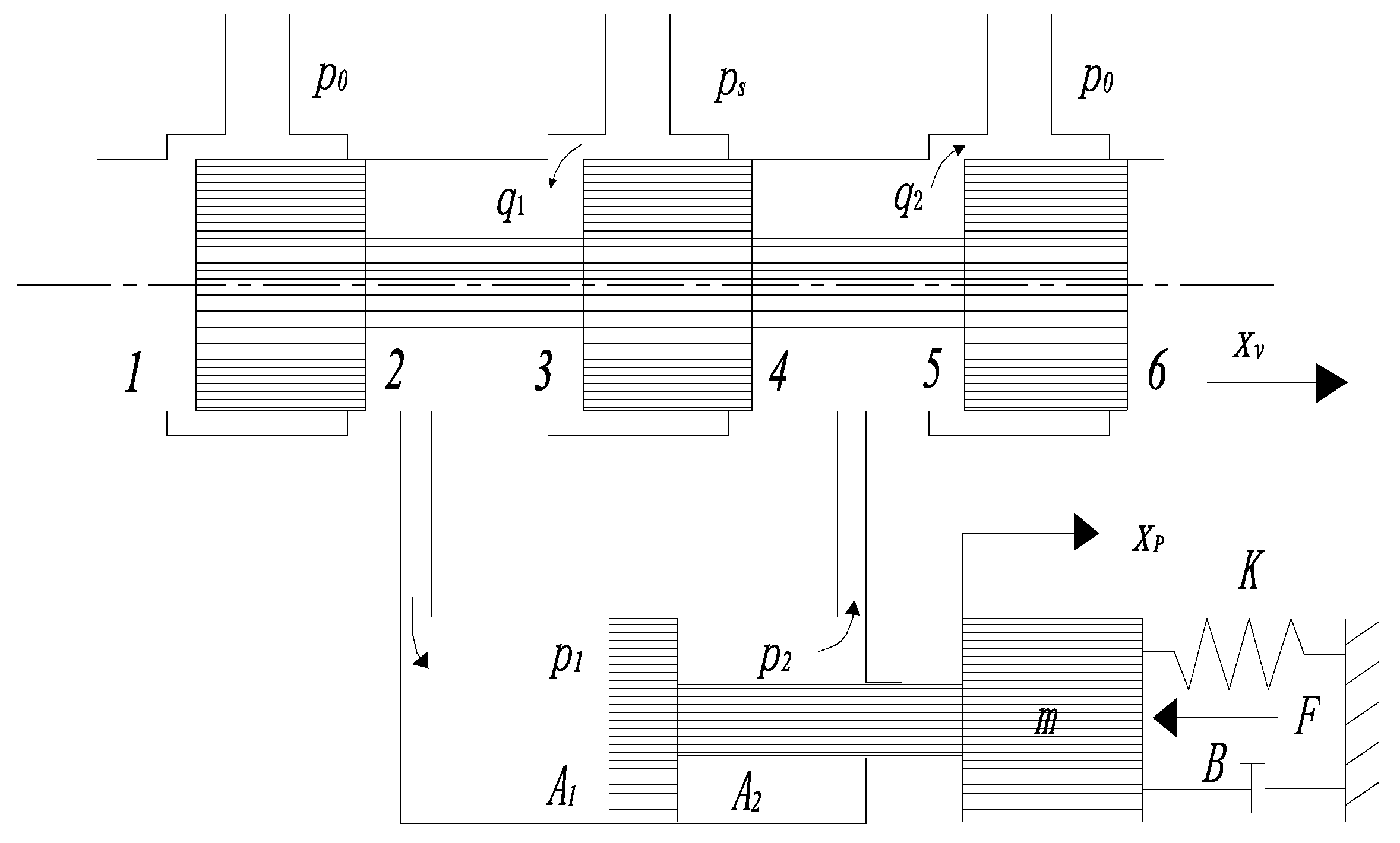

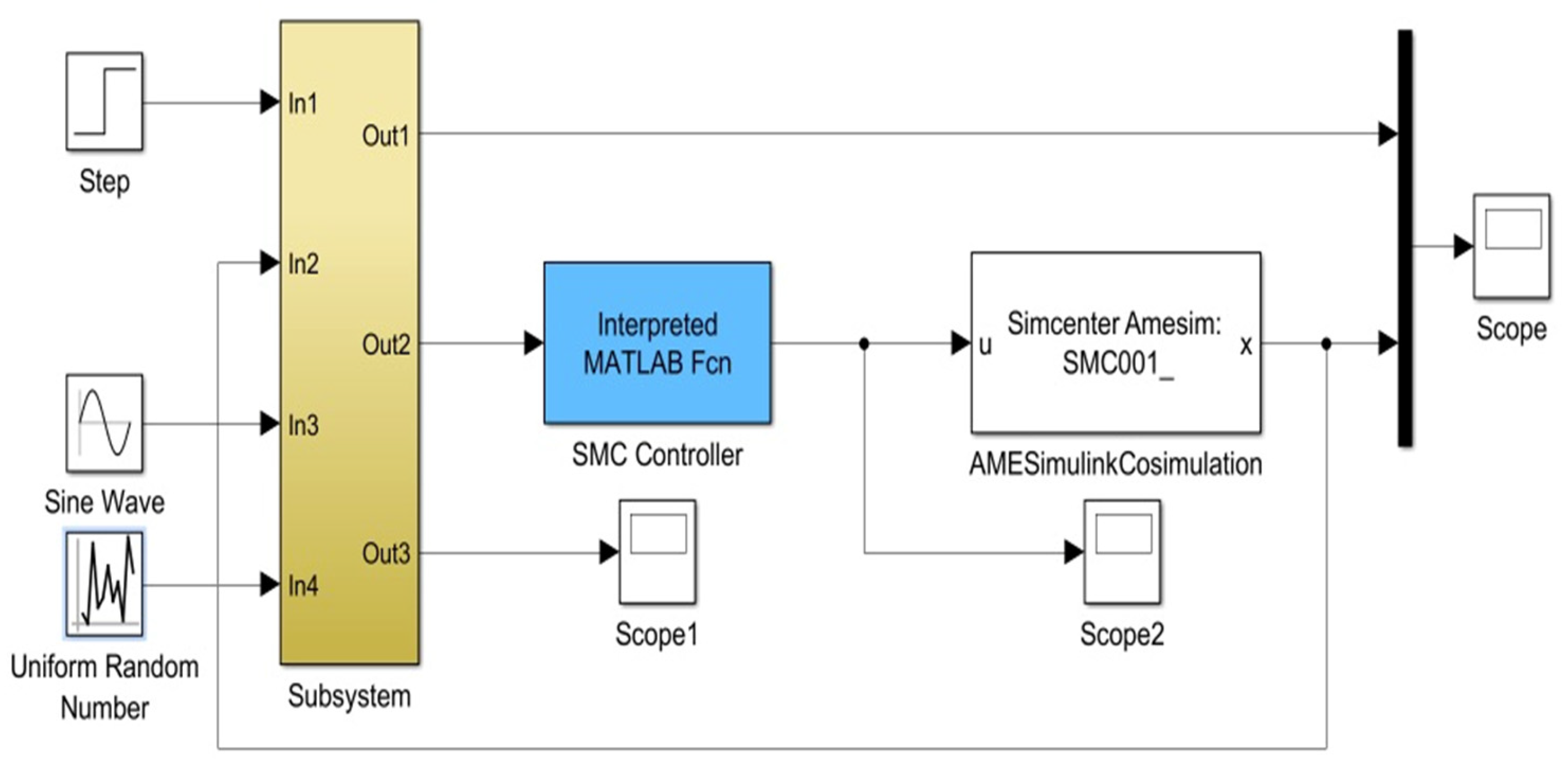

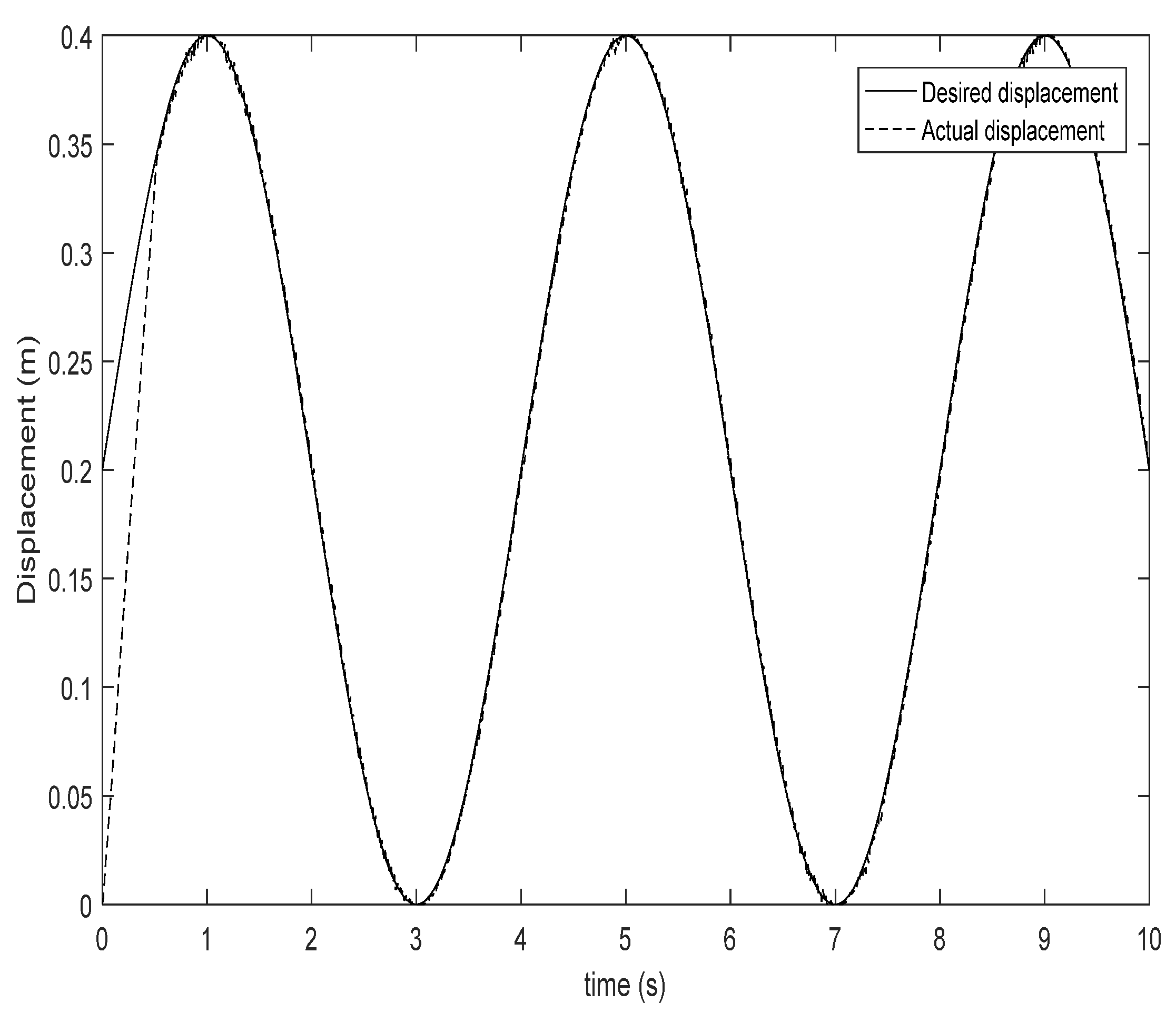

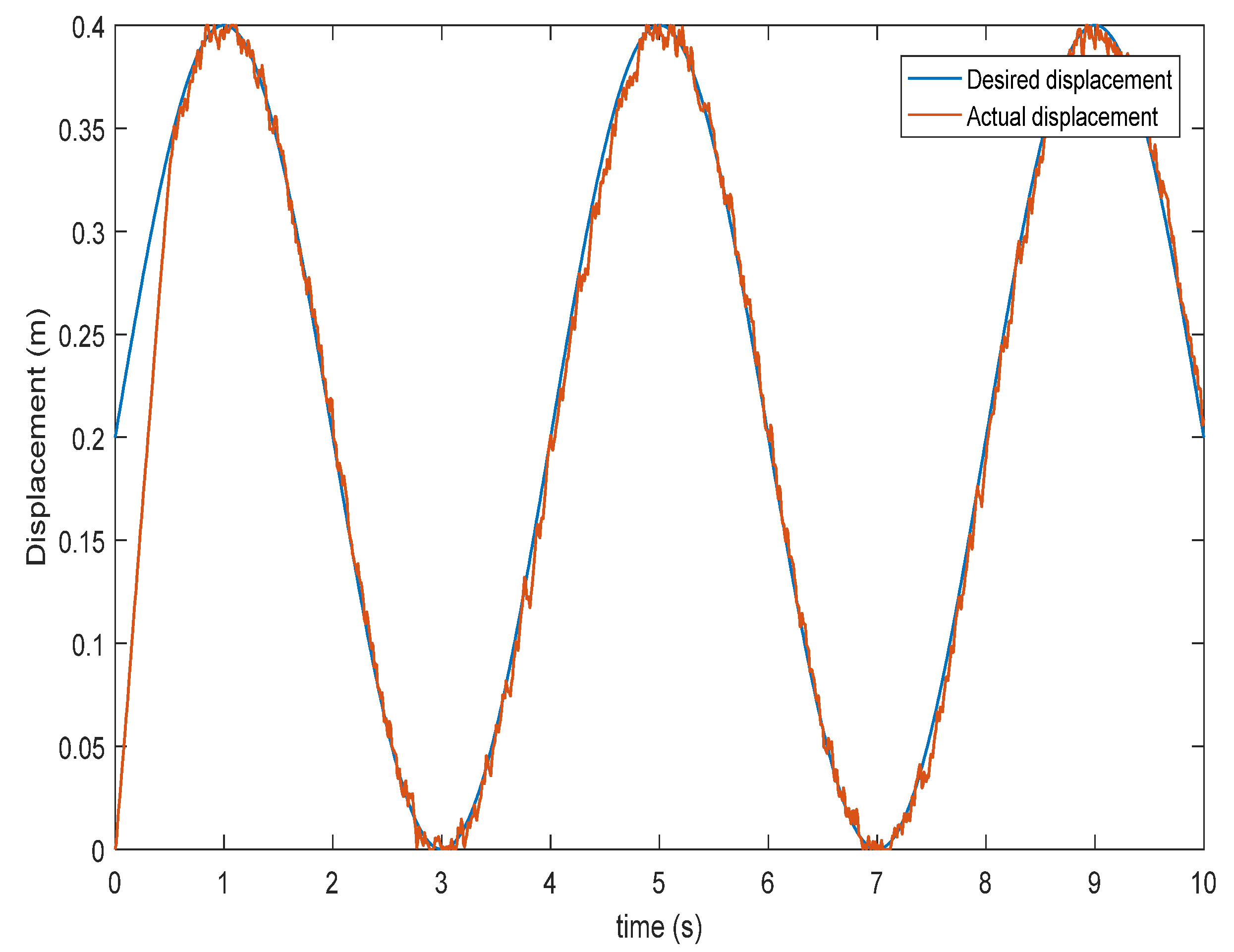

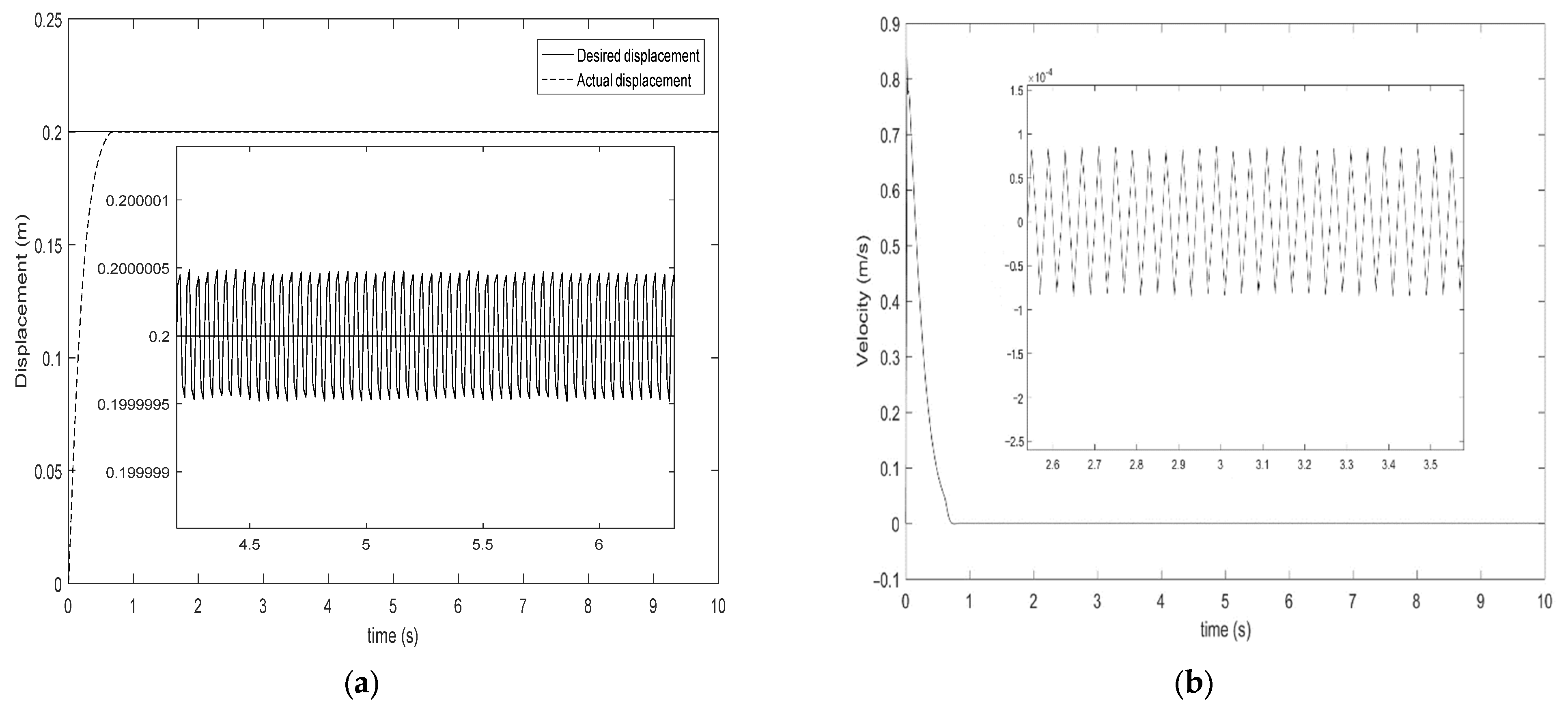
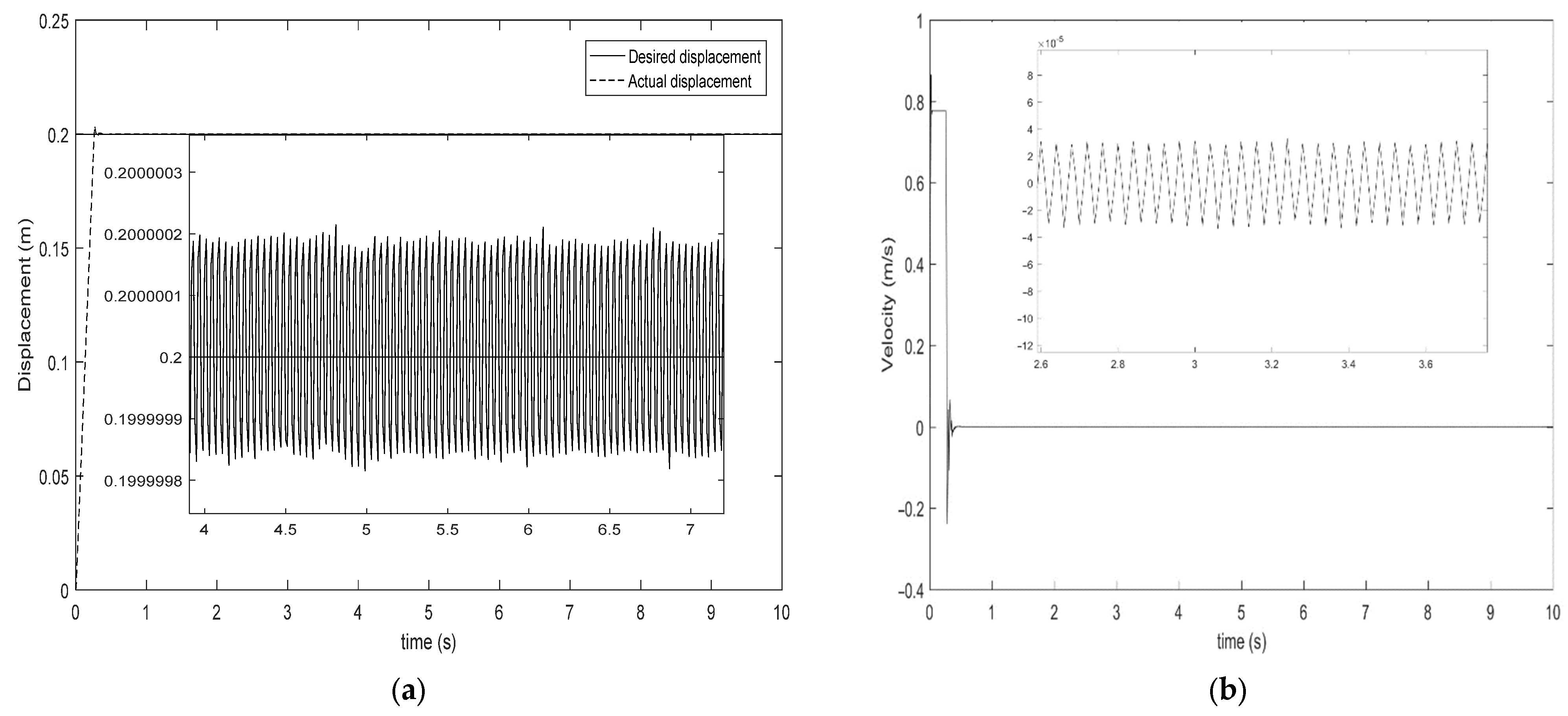
| Name | Parameter |
|---|---|
| Maximum stroke of hydraulic cylinder L | 0.4 m |
| Hydraulic cylinder inner diameter D | 63 mm |
| Piston rod diameter d | 45 mm |
| Servo valve rated voltage u | 10 V |
| Servo valve flow q | 60 L/min |
| System working pressure ps | 15 MPa |
| Oil return pressure p0 | 0 MPa |
| Name | Parameter |
|---|---|
| 1.86 | |
| 29,258 | |
| 68.8 | |
| Parameter | 5 |
| Parameter | 20 |
| Valve-controlled cylinder natural Frequency | 296 rad/s |
| Valve-controlled cylinder damping ratio | 0.2 |
| Name | Parameter |
|---|---|
| 1.86 | |
| 29,258 | |
| 68.8 | |
| Parameter | 5 |
| Parameter | 20 |
| Valve-controlled cylinder natural Frequency | 296 rad/s |
| Valve-controlled cylinder damping ratio | 0.2 |
Publisher’s Note: MDPI stays neutral with regard to jurisdictional claims in published maps and institutional affiliations. |
© 2022 by the authors. Licensee MDPI, Basel, Switzerland. This article is an open access article distributed under the terms and conditions of the Creative Commons Attribution (CC BY) license (https://creativecommons.org/licenses/by/4.0/).
Share and Cite
Sun, C.; Dong, X.; Wang, M.; Li, J. Sliding Mode Control of Electro-Hydraulic Position Servo System Based on Adaptive Reaching Law. Appl. Sci. 2022, 12, 6897. https://doi.org/10.3390/app12146897
Sun C, Dong X, Wang M, Li J. Sliding Mode Control of Electro-Hydraulic Position Servo System Based on Adaptive Reaching Law. Applied Sciences. 2022; 12(14):6897. https://doi.org/10.3390/app12146897
Chicago/Turabian StyleSun, Chungeng, Xiangxiang Dong, Mingjin Wang, and Jipeng Li. 2022. "Sliding Mode Control of Electro-Hydraulic Position Servo System Based on Adaptive Reaching Law" Applied Sciences 12, no. 14: 6897. https://doi.org/10.3390/app12146897
APA StyleSun, C., Dong, X., Wang, M., & Li, J. (2022). Sliding Mode Control of Electro-Hydraulic Position Servo System Based on Adaptive Reaching Law. Applied Sciences, 12(14), 6897. https://doi.org/10.3390/app12146897





